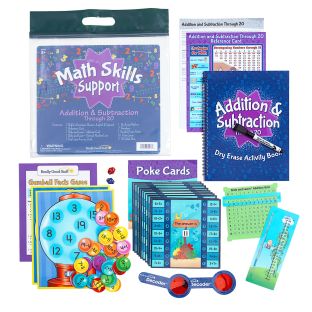Addition & Subtraction – Kindergarten
Popular Kindergarten Addition & Subtraction Materials
Inspire engagement with popular Kindergarten Addition & Subtraction Materials. Our most-purchased Kindergarten Addition & Subtraction Materials are versatile and appropriate in most school environments.
Really Good Stuff’s top Kindergarten Addition & Subtraction Materials enhance experiences for students as well as teachers. Shop our most popular Addition & Subtraction Materials for educators.
Kindergarten Addition & Subtraction Products
Top-Rated Kindergarten Addition & Subtraction Materials | 2025 School Year
Get top-rated Kindergarten Addition & Subtraction Materials from Really Good Stuff. Teachers rate these 11 Addition & Subtraction Materials with an average of 4.8 stars, making them the best Addition & Subtraction Materials.
Explore these Kindergarten Addition & Subtraction Materials loved by students aged 4 to 11 years-old. Through premium Kindergarten supplies, Addition & Subtraction Materials can help your PreK grade to 6th grade class.
Learn More About Kindergarten Addition & Subtraction Materials
Enhance your Kindergarten classroom with Really Good Stuff’s Addition & Subtraction Materials. Our catalog of 34 high-quality Addition & Subtraction Materials start at $5.44 and fit the Kindergarten classroom. From premium brands like Really Good Stuff®, Unifix®, and Koplow, these Addition & Subtraction Materials meet the needs of Kindergarten teachers.
Really Good Stuff’s Addition & Subtraction Materials for Kindergarten students work for 5 years old in Kindergarten. Teachers match Kindergarten Addition & Subtraction Materials with other Addition & Subtraction Materials from the Math category.
Make Really Good Stuff your top choice when looking for Addition & Subtraction Materials for your Kindergarten classroom.
In a Kindergarten classroom, the introduction of addition and subtraction concepts is often done through interactive and engaging methods. Teachers might use manipulatives, such as counting bears, blocks, or colorful beads, to make abstract mathematical ideas concrete and understandable for young learners. Story problems that connect to children’s real-life experiences, like sharing snacks or toys, can also make addition and subtraction relatable and fun. Activities like these not only enhance understanding but also promote active participation and enthusiasm among students as they explore basic arithmetic.
When it comes to choosing addition and subtraction products for your Kindergarten classroom or student, consider these tips to make the most of your investment. First, look for products that are visually engaging and tactile, as these can help maintain the interest of young children while solidifying their understanding of mathematical concepts. Second, ensure the products are age-appropriate; tools and games should be designed with the developmental stage of 4 to 6-year-olds in mind, fostering both curiosity and confidence. Third, seek out items that offer flexibility and multiple uses, such as double-sided boards or manipulatives that can be used for various types of activities, including group work and individual learning.
It’s also essential to recognize the specific needs of Kindergarten classrooms when purchasing these products, as opposed to buying for higher grade levels. Kindergarten students are in the earliest stages of formal education, often encountering structured learning environments for the first time. Hence, products should be safe, durable, and easy to handle, catering to the fine motor skills of young learners. Furthermore, the focus should be on foundational and explorative activities rather than advanced problem-solving tools. By considering these factors, you can create a supportive and stimulating environment that lays a strong mathematical foundation for young minds.
FAQs for Kindergarten Addition & Subtraction Materials
What are the highest rated Kindergarten Addition & Subtraction Materials?
- Addition And Subtraction Through 20 Gumball Facts Game – 4 mats, 80 chips (5 stars) – $38.99
- Solving Problems Two-Sided Dry Erase Boards Set – 6 Boards (5 stars) – $29.99
- Learning Success: Grade K – Reading, Math, and SEL (5 stars) – $29.99
What Kindergarten Addition & Subtraction Materials do teachers use most?
- Learning Success: Grade K – Reading, Math, and SEL (5 stars) – $29.99
- Really Good Stuff® Number Lines 0-10 and 0-20 Dry-Erase Boards – 6 Boards (5 stars) – $19.99
- Solving Problems Two-Sided Dry Erase Boards Set – 6 Boards (5 stars) – $29.99
Can you recommend some budget-friendly Kindergarten Addition & Subtraction Materials?
- Addition And Subtraction Through 20 Gumball Facts Game – 4 mats, 80 chips (5 stars) – $38.99
- Solving Problems Two-Sided Dry Erase Boards Set – 6 Boards (5 stars) – $29.99
- Learning Success: Grade K – Reading, Math, and SEL (5 stars) – $29.99
























